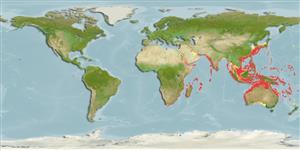Common names from other countries
>
Scombriformes (Mackerels) >
Gempylidae (Snake mackerels)
Etymology: Thyrsitoides: Greek, thyrsites, -ou = stalk of a plant, an ornament like a pine cone borne by Bacchus + Greek, oides = similar to (Ref. 45335).
More on author: Fowler.
Environment: milieu / climate zone / depth range / distribution range
Ecologia
marinhas bentopelágico; intervalo de profundidade 0 - 400 m (Ref. 6181). Deep-water; 39°N - 44°S, 25°E - 134°W (Ref. 6181)
Indo-West Pacific: Red Sea to South Africa and New Caledonia, north to Japan. Recently reported from Tonga (Ref. 53797).
Tamanho / Peso / Idade
Maturity: Lm ? range ? - ? cm
Max length : 200 cm TL macho/indeterminado; (Ref. 4408); common length : 100.0 cm SL macho/indeterminado; (Ref. 9784)
Espinhos dorsais (total): 17 - 19; Raios dorsais moles (total): 16-17; Espinhos anais 1; Raios anais moles: 16 - 17; Vértebras: 34. Two lateral lines, originating above the upper angle of gill opening, branching below the 4th dorsal-fin spine or slightly behind it, upper line running along the first dorsal-fin base and ending below about the end of the first dorsal fin, lower line abruptly curved backward from bifurcation, running mid laterally to the base of the middle caudal-fin ray. Body color is dark brown with slightly metallic reflections, sometimes slightly paler on belly. Dorsal fin membranes with black markings.
Mesobenthopelagic, down to depths of 400 m or more, often at the surface at night around Okinawa, Japan (Ref. 6181). The largest populations are probably on the slope of seamounts or ridges (Ref. 6181). Feeds on a variety of mesopelagic fish, squid and crustaceans (Ref. 6181).
Life cycle and mating behavior
Maturidade | Reprodução | Desova | Ovos | Fecundidade | Larvas
Nakamura, I. and N.V. Parin, 1993. FAO Species Catalogue. Vol. 15. Snake mackerels and cutlassfishes of the world (families Gempylidae and Trichiuridae). An annotated and illustrated catalogue of the snake mackerels, snoeks, escolars, gemfishes, sackfishes, domine, oilfish, cutlassfishes,. scabbardfishes, hairtails, and frostfishes known to date. FAO Fish. Synop. 125(15):136 p. (Ref. 6181)
Categoria na Lista Vermelha da IUCN (Ref. 130435)
CITES (Ref. 128078)
Not Evaluated
Ameaça para o homem
Harmless
Utilização humana
Pescarias: pouco comercial
Mais informação
Nomes comunsSinónimosMetabolismoPredadoresEcotoxicologiaReproduçãoMaturidadeDesovaFecundidadeOvosDesenvolvimento dos ovos
ReferênciasAquaculturaPerfil para aquaculturaEstirpesGenéticaElectrophoresesHereditariedadeDoençasProcessamentoMass conversion
Ferramentas
Relatórios especiais
Descarregue XML
Fontes da internet
Estimates based on models
Preferred temperature (Ref.
115969): 15.3 - 28, mean 23.7 (based on 1045 cells).
Phylogenetic diversity index (Ref.
82804): PD
50 = 1.0000 [Uniqueness, from 0.5 = low to 2.0 = high].
Bayesian length-weight: a=0.00427 (0.00204 - 0.00890), b=3.15 (2.96 - 3.34), in cm Total Length, based on LWR estimates for this species & (Sub)family-body (Ref.
93245).
Nível Trófico (Ref.
69278): 4.2 ±0.58 se; based on food items.
Resiliência (Ref.
120179): Muito baixo, tempo mínimo de duplicação da população maior que 14 anos (Preliminary K or Fecundity.).
Fishing Vulnerability (Ref.
59153): Very high vulnerability (90 of 100).
